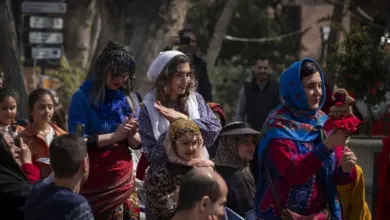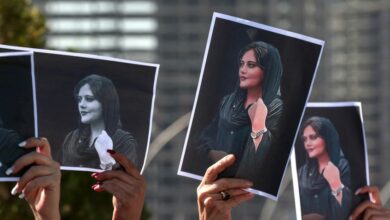
At 15, I never thought I would put it on. And by 18, I never imagined taking it off.
And today, I wear a headscarf, commonly known as hijab, part-time.
More than a year and a half ago, I decided to explore outside the boundaries of my scarf — I removed it. It had taken me six years to make this decision.
The scarf symbolizes a collection of meanings for different Muslim women. Some would argue it is a requirement to cover a woman's hair and adhere to an understood "modest" dress code referenced in the Quran, the Muslim holy book. They consider it a religious duty. A must.
I once did, too.
Others drape it on for social and political motives. At a time when a woman's body is often depicted sexually in the fashion and media industry, it can feel liberating and empowering not caving into these idealized images.
Muslim women in America who reject mainstream fashion standards and choose hijab are making bold social and political statements. They are exercising their freedom of expression as Americans with protected rights, regardless of race, religion or gender.
But these are women who have a choice.
Let me not forget those who are forced to wear hijab unwillingly. They also exist. To their perpetrators, I say, "You do not represent Islam, nor do Muslims want to be associated with you for imposing your political agenda on women."
Then there are those who ban wearing the scarf all-together, unjustly voiding women of their choice of representation.
Both ends of the spectrum of hijab — forcing it on or banning it — are bigotry feeding into egos of individuals obsessed with controlling a woman's image and freedom.
Irrespective of the reason behind the choice to cover, hijab remains an intimate and personal matter — with sticklers on both ends of the wear or not-to-wear controversy, leading to heated debates by scholars within and outside Muslim communities.
Hijab, my niche
I was raised in a traditional household and was among those who did not choose to put on a scarf. Instead I complied and genuinely fell in love with what it symbolized for me: respect, modesty, restraint and dignity. Self-discipline defined it for me.
I was passionate about the topic to the point of becoming a sought-after public speaker on Muslim women and hijab, immersing myself in conducting hundreds of presentations to diverse populations at universities, churches, synagogues and interfaith groups.
I like wearing the hijab. It's beautiful and makes me feel regal and sophisticated. I feel at home wearing it — it is my comfort zone, a part of my lifestyle.
It has become my brand. My niche.
But through life experiences and over the years, my understanding of the scarf has drastically evolved — from a religious duty to a fashion statement and now an authentic form of social expression.
For me, the scarf has always been an unspoken part of my identity. It sits on my head so silently, yet says so much as a symbol. It makes me stand out from the crowd. It screams that I am different. And though my body is physically covered, the scarf puts all of me on display.
Shame and guilt
Most of the time, I receive positive responses while wearing hijab. Many people compliment me on the color of my scarf and style of my wardrobe. But, occasionally, there are outcasts who voice negative remarks reflecting ignorance.
People are also surprised by my free spirit; instead, many express they first perceive me as "serious."
"I thought you were very religious and that I'd have to be careful with what I say," someone once told me.
This was his observation without ever speaking to me. Then he saw a lot of my personality in watching me interact with others and getting to know me more.
The hijab rids me of speech. It speaks for me before I open my mouth. It competes with my outspoken personality.
It says so much about "who" I am, "what" I stand for and "where" I come from before I utter a single word. It speaks the language of assumptions about what it "should" mean — carrying meaning often conflicted with my personal reason for wearing it. It is why I decided to challenge it.
Yet it wraps tightly around my identity, remaining deeply rooted in my core. The thought of removing it entirely would mean eradicating part of my own being. For years, I felt ashamed and guilty for my thoughts. I battled with it in silence.
It was shame, guilt and stigma of being a Muslim woman of influence that delayed my decision. I did not want to let anyone down. Instead, I let myself down every day I reluctantly wore it before leaving home.
The delay led to more anxiety and confusion. I secretly desired trying the opposite of what I have been doing for most of my life. I wanted what I was deprived of — my right to decide for myself. I needed to remove it and re-evaluate what it symbolized for me personally.
Thoughts about the scarf became a distraction. Not to others, but to myself. Constant contemplations of whether to take it off or keep it on weighed me down and consumed my soul. The peace I once had in loving hijab turned into resentment.
It was time to make a decision.
A choice
I finally removed it for my comfort and ease of mind. I removed it because at times I felt limited to others' interpretation of hijab and suffocated with it on my head.
I simply took it off to unload the burden of an unjustified, incomplete and inaccurate explanation for an entire community by what was wrapped around my head.
I removed it to understand myself for who I truly am beneath the scarf, not what I assumed I had to be for wearing it.
I removed it to experience what I was deprived from.
I removed it to detach the person from the object — to just be human.
I removed it to find myself.
Outside the boundaries
I remember the feelings inside me for the first time walking around without it — so exposed and vulnerable — as if I was naked.
Simultaneously, I felt lighter and truer to my heart and soul. I no longer had to be alone in my thoughts of wonder. I could experience them on my own. I felt transparent and carefree.
Exploring outside of hijab by wearing it sometimes gives me room to breathe and think about the ultimate purpose of life for all humanity. It challenges my choices, decisions and beliefs.
Through my studies and teachings of Islam for many years, I've come to learn there are no boundaries other than the ones we set within.
I spent many of my youth years at mosques learning or teaching about women in Islam, marriage, jurisprudence, Quranic studies and the Arabic language. I am grateful I did. It is what instilled conviction in my heart that varying meaning exist within the realm of what is and is not forbidden in life — nothing is definitive. Life's journey breeds change, and it must be embraced for growth.
I no longer allow for the scarf to define me. I define it.
Muslim by character
I commend every woman who decides to wear hijab, and I respect those who choose the opposite. Either way, if it is a personal choice, I support it.
Maybe I will eventually remove hijab permanently. Or perhaps keep it on full-time. I don't pretend to know the future or have all the answers. For now, I am at peace with my decision to explore.
My 8-year-old daughter seems to have it all figured out sooner than I did. In sharing with her my decision, she responded with, "Mom, you are not a Muslim by what you wear, you are one by your character."
I am a Muslim and for that I am an advocate of choice. Choice for everyone and in everything, scarf and beyond. As the Quran says, there is no compulsion in religion.
Life is about choosing experience, without guilt or shame. It is about exploring to find and become our highest selves. By choice.




